Hey there. It’s been a long time, I shouldn’t have left you…2017 has been a great year for wine auctions, but not for my tasting notes, at least publishing them. I still have a lot of notes, I just haven’t been able to get them out. Need to work on that. With the Fall season arriving and an extremely exciting September already in my air, I finally sat down and started to dig into dozens of pieces of papers of notes, and then, of course, I had to start here.
There was one weekend in 2017 that I could not let pass me and my notes by, and that was our ‘Greatest Wines of the World Weekend,’ held this past May. Collectors came from all over the country, and even outside the country, to New York City for three extraordinary meals at New York’s finest restaurants: 11 Madison, Daniel and Per Se for three days of Bacchanalian bliss.
Thursday night was at 11 Madison, some publications’ #1 restaurant in the world. Sometimes being #1 isn’t enough, as they recently closed for a renovation, I think in July. We kicked things off with a flight of the best Champagne on Earth, Krug’s Clos du Mesnil. We had an inauspicious beginning with a less than perfect bottle of 1996 Krug Clos du Mesnil. Usually this wine is in the 98 point territory for me, but this bottle seemed more open than usual, a bit shut down and not possessing its usual, blistering acidity. I wasn’t sure what exactly was off about this bottle, but I’ve had it enough times to know this one wasn’t perfect (95A).
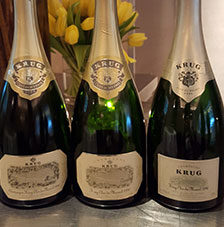
Let’s Get This Party Started
We quickly got back on track with a 1990 Krug Clos du Mesnil. This was a big, heavy and muscly Champagne. It was long and zippy, full-bodied and flat-out great. This was the definition of brawn for bubbly, and its palate added nice grassy and earthy components to go with its rippling fruit (96).
The 1988 Krug Clos du Mesnil had the best nose, showing the most fruit and a full kaleidoscope of yellow aromas and flavors. It came across richer accordingly. This was sunshine in a glass, just starting to show some mature flavors, yet still rip-roaring with its acidity and finish. Dave noted, ‘the oldest is the freshest’ (98).
A trio of rare Raveneaus led the white wines to the dinner table, the first being a 1986 Raveneau Blanchot. I think Roy said this was the only wine the entire weekend where he couldn’t find a tasting note anywhere, like ever, either this or the Valmur, for sure, so brace yourselves for the first official tasting note all-time for one of these lol. The Blanchot had a spiny nose with lots of anise, with a touch of what I call ‘windex,’ but not in a negative way. Its palate was lemony a la twisted citrus, and tasty with a bit of youth left to it. This was a delicious Raveneau, but it seemed a touch lesser after the next two wines. It was still Bill’s favorite, as he found it ‘super pure and fresh’ (94).
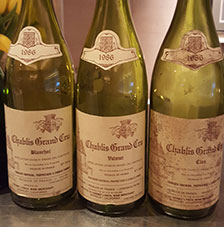
Three of a Kind
The 1986 Raveneau Valmur was noticeably fuller and richer, and its flavor profile was similar to that of the Blanchot. These were definite birds of a feather, but the Valmur had more layers with its bigger and broader personality. It added some extra complexity of flint and fireplace flavors, and additional flavors of honey and grass while wild herbs emerged. Cam appreciated its ‘nuttiness,’ while another found it the ‘most complex’ of the flight (96).
The Raveneau hierarchy held to form, as the 1986 Raveneau Les Clos was fantastic and my favorite of the flight. There was a pinch more sweetness to the Clos, with kisses of exotic fruits. There was also this gingerbread edge that flirted with all of its other exotic spices. Dave admired the classic ‘oyster shell,’ and I kept writing exotic over and over. It definitely danced on my palate (97).
It was on to Montrachet, but we had an oxidized 2002 DRC Montrachet next. It really sucks when a 5k bottle is off, but we carried on unfazed (DQ).
The 2001 DRC Montrachet was rich and sweet, displaying more tropical qualities and that usual kiss of botrytis that DRC’s Montrachets can often have. There was a bit of coffee and cocoa to this big and long-lasting white. Its finish was another category compared to the Raveneau, and the wine’s power really kicked in on the way down. This was a bruiser versus the ballerina that would follow (95).
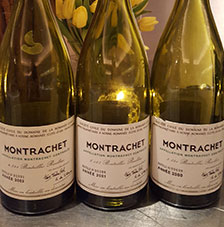
It’s as Easy as 01, but Not 2
The 2000 DRC Montrachet was the ballerina, displaying that cleanness and freshness of the vintage, and while it was long and lingering, it was in a much more elegant way. This was classic 2000, and sheer pleasure to drink, although I am not sure it will be getting any better (97).
Bordeaux was next, beginning with a trio of 1982s. It’s tough to reconcile how when I started in the business about 20 years ago, the 1961s were in the same spot that the 1982s are now. They are now the 61s of twenty years ago! Somehow, it just doesn’t compute, but that’s what it is. We kept it all Pauillac, and all First Growth, beginning with the 1982 Lafite Rothschild. The Lafite has always been one of the more elegant ’82s, and this bottle was clean and lean with long and pleasing, classic qualities. The pencil and cedar dueled in its nose, and LA Confidential found its ‘perfume longer.’ This was a beauty not a beast, and surprisingly good with a beet dish, although I was dreading the combination. It actually pushed it from that 95/96 point border to (96).
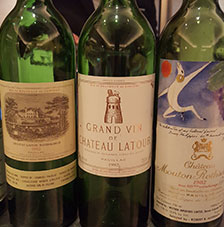
The 61s’ of Today?
The 1982 Latour has always been one of my favorite ’82s, and this bottle clearly showed why. It took a little time to shake off some cobewebs/must, but once it did, it was so much richer and deeper than the Lafite. It was even inky in a Bordeaux way. Its palate was rich, thick and long with shades of walnut. Its purple and cassis seemed endless. One day everyone will wake up and this wine will be $1k more a bottle, which is still $1k less than the average ’61 (98).
The 1982 Mouton Rothschild is one of my other all-time faves from the vintage, but in a different way. This wine has always been the wine I would want in 2050, God willing. It is still such a tight wine. There was great cigar box to its nose, but this was clearly a wine about structure. There was some nut and carob here, and the Carolina Panther found ‘earth and mushrooms.’ The wine thickened in the glass, almost daring you to drink it over the next 24 hours (97+).
We went from one end of the Bordeaux spectrum to the other, as in a flight of 1928s. The 1928 Palmer was an all-star bottle, and actually the consensus favorite of the flight. It had what I would call a perfect claret nose. It was sweet with cassis, tobacco, candle wax and cream. It was like a good day on Wall Street: rich but getting richer by the minute. The Jackal gave it 98 points, and I had to agree (98).
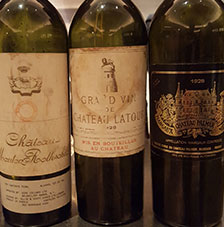
Everlasting
The 1928 Mouton Rothschild was surprisingly lighter than the Palmer. There was more dryness showing in the Mouton, along with more cobwebs and old library. This bottle was on the drier side and no match for the Palmer despite a pleasing personality in general (94).
If there were a “king of the business” in 1928, it would have to be the 1928 Latour. While the Latour was clearly the longest wine of the flight, it was also much more elegant than I remembered. Of course, at this age, there is so much bottle variation, even within the realm of positive experiences, which this certainly was. Its acidity really stood out, and this high-pitched Latour definitely hit a high note, just not as high as the Palmer (96).
We segued to Italy next and a trio of Giacosas, and a trio of Santo Stefano Riservas. The 1978 Giacosa Barbaresco Santo Stefano Riserva was a bit peculiar, and far from my cherished memories of this wine. It has been a while, I will confess. The ’78 had this Dr. Brown’s celery soda thing happening, with lots of hay, animal and brown sugar. It was browning in general, but I didn’t think the wine was off. Maybe it was (93?).
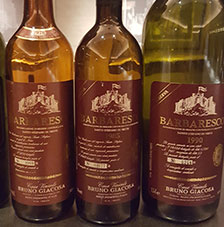
Lost in Translation
The 1985 Giacosa Barbaresco Santo Stefano Riserva was similar to the ’78 somewhat, but richer with more fruit and more of that flavor I was looking for. This was a solid wine with a gritty finish and dry desert flavors (95).
The 1990 Giacosa Barbaresco Santo Stefano Riserva was served out of magnum, which in retrospect was probably a mistake. It was just too young. This was even drier than the first two, but it was also longer and zippier, no doubt aided by the magnum factor. This was tight, dry and unyielding. I must say while I am a huge fan of Giacosa, I was quite disappointed by this flight. “Tough company?” I questioned (94M).
Three vintages of Jayer Cros Parantoux are a good cure for a disappointing flight, especially when the first is a 1991 Henri Jayer Vosne Romanee Cros Parantoux. Its nose was all about the deep purple, with enough earth and vitamins to support a small colony. This was deep, deep inside my mind with just one whiff. Thick and long, it was still a baby. It was powerful and dense with great expression on its finish. The Jackal found it had “the most length” of the flight, and he was right again. He must have been copying my notes (98).
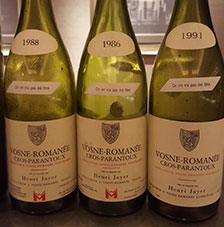
The One and Only
While the 1988 Henri Jayer Vosne Romanee Cros Parantoux was still outstanding, it seemed simple compared to the 1991. Maybe closed is a better word choice. It was a clean, lean, fighting machine that was nice but not as naughty as I would have liked (94).
The 1986 Henri Jayer Vosne Romanee Cros Parantoux was tasty and creamy, showing more flesh and game than either of the previous two wines. This was open for business by comparison. Jayer was a master of the “off” vintages like 1986, but the words “off vintage” seem like a misnomer, especially in today’s Burgundy world. The ’86 had a great m_lange of fruit flavors, showing all different types of skin, but mainly red, purple and black (95).
Where could we go from here? Three DRC wines from 1978? Oh, ok, fine : ) The 1978 DRC Echezeaux was full of beef, blood, rose and menthol. There were beautiful citrus flavors, and it possessed all the autumn goodness of Fall in New York City. It was older, but not old, and it definitely outboxed its weight class. This was the little engine that could in this flight (96).
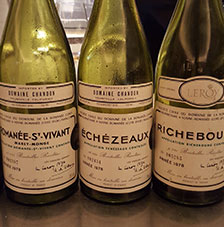
Starring Echezeaux
The 1978 DRC Romanee St. Vivant was solid. It was big and full-bodied with a long, minerally finish. The Mogul wasn’t feeling it, and it was a bit dry and dirty compared to the Echezeaux. The RSV was fuller, but not better. Many feel DRC’s RSV really started to achieve what it should over the last twenty years, and that earlier vintages are always good but never great (94).
The last wine of this illustrious flight was much gamier and open compared to its siblings. The 1978 DRC Richebourg was open like 24-7 and almost syrupy with more concentration. This was the richest and heaviest of the flight, but the Echezeaux kind of stole its show (96).
Three Chaves from 1990 were the last flight on this night, and we snuck in a 1990 Chave Hermitage Blanc. I love going back to great whites after reds; I don’t think enough people realize that you can. It almost serves as a palate refresher. The Chave Blanc was marzipan city. It was just hitting that point of maturity where it felt ready. Dave admired its ‘texture’ (94).
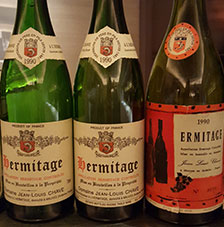
Take This Cork and Chave It
The night was coming to a close, and so were my note-taking skills. “Bacon, blood, pig, beef, smoke”summed up the 1990 Chave Hermitage. And notes of Viognier, even though I am not sure any is in it lol. It was damn good (96).
The 1990 Chave Ermitage Cuvee Cathelin was corked. Fuuuuuuuck. Two 5k bottles down the drain. No one said fine and rare wine was easy. Thankfully, everyone in attendance understood these things happen and didn’t let it affect their spectacular night (DQ).
There was one more 5k bottle to go, a 2005 Egon Muller Goldkapsel TBA. All I had in me was ‘spectacular’ and ‘so sweet’ (97).
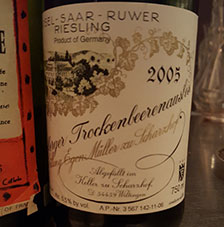
TBA TBD
While this was an amazing evening in every which way (let’s not forget food and company), it was a bit of a warmup for the two sessions that would follow. It was taxi time, and in less than 24 hours we would be at Daniel, doing it all over again.
In Vino Veritas,
JK
